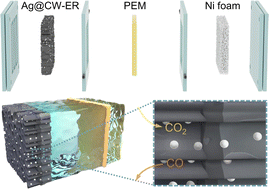An integrated carbonized wood-based gas-diffusion electrode for high-current-density CO electrosynthesis in flow cells†
Abstract
A high-current-density CO2 reduction reaction (CO2RR) can be realized in flow cells and membrane electrode assemblies (MEAs) based on the use of gas-diffusion electrodes (GDEs). However, transitional GDEs based on powdery electrocatalysts are usually fabricated using a laborious slurry-based process that involves the use of binders and additives, leading to insufficient activity and stability. In this work, an integrated GDE is developed by employing carbonized wood as a conductive and porous host for reconstructed Ag nanoparticles (Ag@CW-ER). The porous carbon matrix with an abundance of open, aligned microchannels facilitates CO2 diffusion and electrolyte transportation. The uniformly embedded reconstructed Ag nanoparticles provide numerous active sites that enhance CO2 adsorption and activation during CO2 electroreduction. When tested in H-type cells, it offers a high faradaic efficiency (FECO) of 88.6% for CO production at −0.97 V vs. the reversible hydrogen electrode (RHE) with a high partial current density (jCO) of −22.6 mA cm−2. Most notably, after a simple hydrophobic treatment, the Ag@CW-ER electrode can be directly used as an integrated GDE with well-established and stable three-phase interfaces in the flow cells, achieving a jCO of −186.7 mA cm−2 at −1.31 V vs. RHE with excellent stability for 8 h. This work offers an effective strategy towards the rational design of carbon-based integrated GDEs for sustainable CO2 electroreduction at a large scale.



 Please wait while we load your content...
Please wait while we load your content...